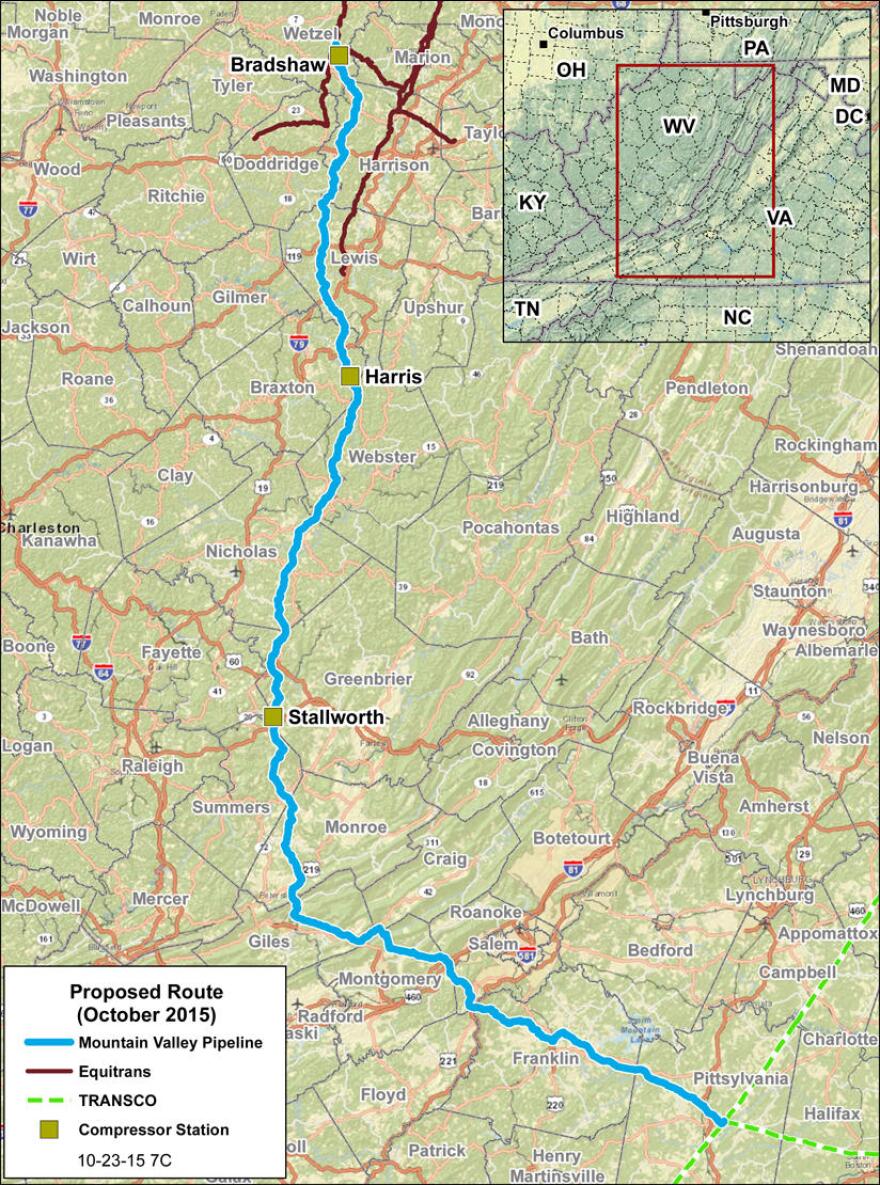The proposed Mountain Valley and Atlantic Coast pipelines are slated to carry natural gas from West Virginia through Virginia, and in the case of the Atlantic Coast pipeline, on into North Carolina. Even as construction has been halted or limited by legal challenges, opposition to those projects remains strong among some residents. WMRA’s Randi B. Hagi reports.

A small crowd gathered in a chapel on the grounds of Trinity Episcopal Church in Staunton on one October afternoon. They sang, not hymns, but protest songs.
[singing]
The event was hosted by the organization Beyond Extreme Energy, a network of activists that aims to raise awareness about the impacts of hydrofracking and other practices by fossil fuel industries. They came to Staunton as part of a “roadshow,” promoting their campaign to dissolve the Federal Energy Regulatory Commission, or FERC, and set up a Federal Renewable Energy Commission in its place. FERC is responsible for approving interstate infrastructure that transmits natural gas, oil, and electricity.

CATHY STRICKLER: They are known to be a “rubber stamp” agency.
Cathy Strickler, a retiree-turned-climate activist from Harrisonburg, attended the event.
CATHY STRICKLER … with approving all applicants except for two in about the last 30 years. But … two of the commissioners did not vote for approval of the ACP and MVP, because they said they had concerns about the need, and the environmental impacts.
Opponents of the pipelines cite accelerated climate change, health and safety risks, ecosystem destruction, and the abuse of eminent domain as reasons for their activism. Strickler is involved with a community group known by the acronym RAPTORS, which co-hosted the Staunton gathering. It stands for –

JOSH VANA: The Rockingham Alliance for the Protection and Transformation of Our Resources and Society.
Josh Vana has participated in RAPTORS since the group formed in 2016 in support of the resistance against the Dakota Access Pipeline. Now, the group focuses on the two new pipelines passing through Virginia.
VANA: … whether that’s showing up to a state Water Control Board meeting … or an Air Pollution Control Board meeting in Richmond, or … raising money to support direct action in Southwest Virginia blocking construction of the Mountain Valley Pipeline.
The direct action Vana is referring to is the Yellow Finch tree sit in the path of the Mountain Valley pipeline near Elliston, a small town just west of Roanoke. A tree sit is a civil disobedience tactic in which a protestor lives on a platform, elevated in the trees, to impede construction efforts in that area. The Yellow Finch tree sit has now been continuously occupied for more than 400 days. RAPTORS held a fundraiser for the activists in January, and is planning another for early 2020.
VANA: We had a fundraiser called ‘Still Here,’ and it was to celebrate and support the direct resistance to the Mountain Valley Pipeline in Southwest Virginia, as well as West Virginia … the support that we raised, either in cash donations or material goods have just been one little helping hand for our friends up in the trees and their trusty ground support.
The Atlantic Coast pipeline will pass closer to home – through Highland, Augusta, and Nelson counties. Stan Driver, who lives in Augusta County, attended the Beyond Extreme Energy event to stay up to date on the pipeline’s progress and permitting struggles.

STAN DRIVER: The pipeline is going to pass within about a half a mile of my house. And run up the valley along the creek, all the way to the mountain … It alarms me, because I live right on Back Creek, and near Sherando Lake, and I’m aware that if they do all this industrial drilling, the spoil that comes from that, it’s gonna sediment Back Creek, it will probably wind up in Sherando Lake, it will deface the side of the mountain there in such a beautiful place where we all live.
As part of the roadshow, the activists screened a 15-minute video denouncing the relationship between FERC and natural gas pipelines.
VIDEO: FERC allows tree clearing and construction to begin on homeowners’ property before states issue legally required air and water quality permits. [SOUND OF TREE FELLING]
The narrator in that clip is Andy Hinz, who is traveling with the Beyond Extreme Energy roadshow. He spent most of his professional career working for FERC, in the IT department.

ANDY HINZ: The whole time I was working I had in my mind that when I retired, I wanted to volunteer to do something about the environment … I just had the ‘woke’ moment where it’s like, you know, are we done? Is the earth gone? And once you come to that realization, it kind of consumes you, ‘cause you’re worried about every living thing on the planet.
Cathy Strickler had a similar epiphany when she and her husband Charlie assisted with relief efforts in Mississippi after Hurricane Katrina, and they began researching the connections between fossil fuels, climate change, and extreme weather events.
CHARLIE STRICKLER: Then I started reading the science, and understanding what was going on. The facts of science are real, and we need to move on it. So yeah, it has become a mission.
The Stricklers traveled to Washington, D.C. in September to march in the global climate strikes.
CHARLIE STRICKLER: We have spent a lot of time spinning our wheels, because it’s always the choir that comes, and that’s why I’m so thrilled to see the young people finally starting to jump in … it’s their future, not mine.
[singing …]


